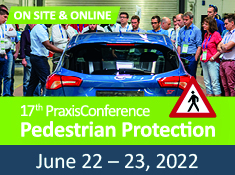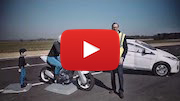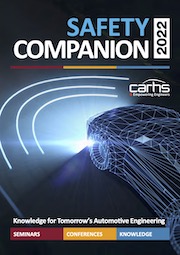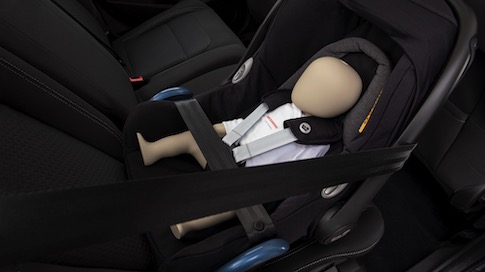 The innovative child dummy enables the functional testing of child presence detection systems in the passenger cabin according to the Euro NCAP protocol. The MESSRING CPD dummy replicates the breathing impulse and presence of a sleeping newborn child in a realistic and reproducible way.
Image: MESSRING
read more ... 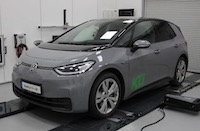 P-AEB tests have so far only been published for combustion engines powered passenger cars. In order to gain experience regarding the test procedure with battery electric vehicles, the KTI carried out the test procedure with such a vehicle. P-AEB tests have so far only been published for combustion engines powered passenger cars. In order to gain experience regarding the test procedure with battery electric vehicles, the KTI carried out the test procedure with such a vehicle.
Image: KTI
read more ... 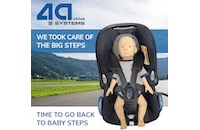 4activeSystems has developed a Newborn 4activeOD Dummy for Child Presence Detection. 4activeSystems has developed a Newborn 4activeOD Dummy for Child Presence Detection.
Image: 4activeSystems
read more ... 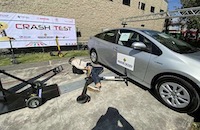 Within the framework of the press conference "Vehicles of individual mobility", in which the first impact tests of electric scooters in Latin America were presented, Miguel Guzmán Negrete, director of road safety of CESVI Mexico explained that one-person vehicles known as electric skates or e-scooters reach speeds of up to 35 km/h in just 3 seconds, and technically speaking, they generate considerable kinetic energy capable of causing significant injuries to both the driver himself in the event of a fall or crash, as well as the pedestrian who ran over. Within the framework of the press conference "Vehicles of individual mobility", in which the first impact tests of electric scooters in Latin America were presented, Miguel Guzmán Negrete, director of road safety of CESVI Mexico explained that one-person vehicles known as electric skates or e-scooters reach speeds of up to 35 km/h in just 3 seconds, and technically speaking, they generate considerable kinetic energy capable of causing significant injuries to both the driver himself in the event of a fall or crash, as well as the pedestrian who ran over.
Image: CESVI Mexico
read more ...  The Insurance Institute for Highway Safety and the Highway Loss Data Institute petitioned in March 2022 federal regulators to require manufacturers to equip all new passenger vehicles with automatic emergency braking (AEB) systems capable of detecting and avoiding pedestrians in the dark as well as in daylight. The Insurance Institute for Highway Safety and the Highway Loss Data Institute petitioned in March 2022 federal regulators to require manufacturers to equip all new passenger vehicles with automatic emergency braking (AEB) systems capable of detecting and avoiding pedestrians in the dark as well as in daylight.
Image: IIHS
read more ...  Electronic data recorders, which will be mandatory in new models of car from this summer, will be of little use to safety experts due to a ban on the retrieval of data containing location, date and time information from the devices, according to ETSC. In Jahnuary 2022, the European Commission published the final technical specifications for the devices, which are one of a number of mandatory new technologies agreed as part of a 2019 update of EU vehicle safety laws. Electronic data recorders, which will be mandatory in new models of car from this summer, will be of little use to safety experts due to a ban on the retrieval of data containing location, date and time information from the devices, according to ETSC. In Jahnuary 2022, the European Commission published the final technical specifications for the devices, which are one of a number of mandatory new technologies agreed as part of a 2019 update of EU vehicle safety laws.
Image: ETSC
read more ... 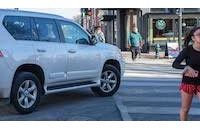 SUVs, pickups, vans and minivans are substantially more likely than cars to hit pedestrians when making turns, suggesting that these larger vehicles may not afford drivers as clear a view of people crossing the road, a new study from the Insurance Institute for Highway Safety shows. SUVs, pickups, vans and minivans are substantially more likely than cars to hit pedestrians when making turns, suggesting that these larger vehicles may not afford drivers as clear a view of people crossing the road, a new study from the Insurance Institute for Highway Safety shows.
Image: IIHS
read more ... 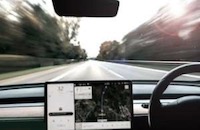 Automated Lane Keeping Systems (ALKS) will be the first true step towards Automated Driving. ALKS will legally allow the driver to take their hands and eyes off the road, enabling them to participate in other activities such as watching media content on the in-vehicle display and the system functionality has been defined by the UN under Regulation 157. Initially, ALKS will only be functional in certain conditions, such as on a fully-fledged motorway where oncoming traffic is physically separated, at a maximum operational speed of 37 mph (60 Km/h). Automated Lane Keeping Systems (ALKS) will be the first true step towards Automated Driving. ALKS will legally allow the driver to take their hands and eyes off the road, enabling them to participate in other activities such as watching media content on the in-vehicle display and the system functionality has been defined by the UN under Regulation 157. Initially, ALKS will only be functional in certain conditions, such as on a fully-fledged motorway where oncoming traffic is physically separated, at a maximum operational speed of 37 mph (60 Km/h).
Image: Thatcham Research
read more ...  The ENSEMBLE consortium held its final public event on 17 March 2022 to mark the end of the 46-month project on 31 March 2022. The event was an occasion to discuss the achievements and the results of the project with experts and high-level speakers, contributing to the debate about the adoption of multi-brand platooning in Europe. The ENSEMBLE consortium held its final public event on 17 March 2022 to mark the end of the 46-month project on 31 March 2022. The event was an occasion to discuss the achievements and the results of the project with experts and high-level speakers, contributing to the debate about the adoption of multi-brand platooning in Europe.
Image: ENSEMBLE
read more ... 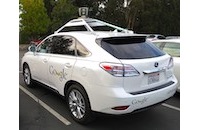 A new report from the UK s independent law commissions recommends introducing a new Automated Vehicles Act, to regulate vehicles that can drive themselves. It also recommends drawing a clear distinction between features which just assist drivers, such as Tesla s Autopilot, and those that are fully self-driving. A new report from the UK s independent law commissions recommends introducing a new Automated Vehicles Act, to regulate vehicles that can drive themselves. It also recommends drawing a clear distinction between features which just assist drivers, such as Tesla s Autopilot, and those that are fully self-driving.
Image: ETSC
read more ...  The European Commission published preliminary figures on road fatalities for 2021. An estimated 19 800 people were killed in road crashes last year. This was an increase of 1 000 deaths (+5%) on 2020, but still represents almost 3 000 (-13%) fewer fatalities compared to the pre-pandemic period in 2019. The overall target is to halve the number of deaths by 2030. EU-wide, the last decade saw a fall of 36%. The European Commission published preliminary figures on road fatalities for 2021. An estimated 19 800 people were killed in road crashes last year. This was an increase of 1 000 deaths (+5%) on 2020, but still represents almost 3 000 (-13%) fewer fatalities compared to the pre-pandemic period in 2019. The overall target is to halve the number of deaths by 2030. EU-wide, the last decade saw a fall of 36%.
read more ... 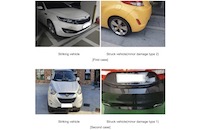 In 2021, a total of 155 cases of engineering analysis data on the risk of injury to vehicle occupants in the event of a minor accident were provided to give a service for auto insurance companies to support appropriate insurance payments. The scope of the service is an accident in which damage less than a scratch or a dent of the bumper cover or the exterior panel that meets the "minor damage repair standards" occurs, or an accident in which the struck vehicle's "velocity change" is 8 km/h or less. In 2021, a total of 155 cases of engineering analysis data on the risk of injury to vehicle occupants in the event of a minor accident were provided to give a service for auto insurance companies to support appropriate insurance payments. The scope of the service is an accident in which damage less than a scratch or a dent of the bumper cover or the exterior panel that meets the "minor damage repair standards" occurs, or an accident in which the struck vehicle's "velocity change" is 8 km/h or less.
Image: KART
read more ...  National Transportation Safety Board Chair Jennifer Homendy challenged local advocates and safety leaders March 15th, 2022 to "fight like hell" and use the Safe System Approach" to reduce rising deaths and injuries on our nation's roads. The Safe System Approach is a proven way to reduce highway deaths and injuries by taking a holistic look at the entire roadway system, from planning to design to use - making all roads safer for all roadway users. Moving to a Safe System Approach is on the NTSB's Most Wanted List of transportation safety improvements and has recently been embraced by the U.S. Department of Transportation. National Transportation Safety Board Chair Jennifer Homendy challenged local advocates and safety leaders March 15th, 2022 to "fight like hell" and use the Safe System Approach" to reduce rising deaths and injuries on our nation's roads. The Safe System Approach is a proven way to reduce highway deaths and injuries by taking a holistic look at the entire roadway system, from planning to design to use - making all roads safer for all roadway users. Moving to a Safe System Approach is on the NTSB's Most Wanted List of transportation safety improvements and has recently been embraced by the U.S. Department of Transportation.
Image: NTSB
read more ...
Register now! carhs.training seminars and events for automotive safety.
All seminars are available as in-house trainings in both German and English!
Please find the full list of seminars at our website.
|




